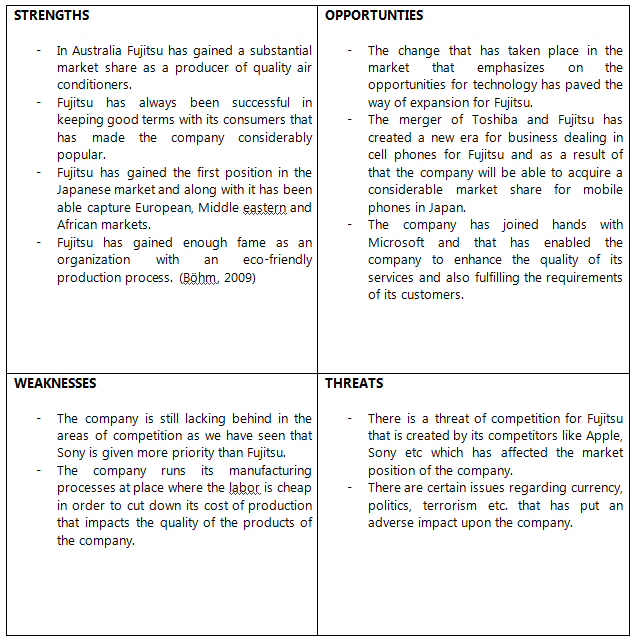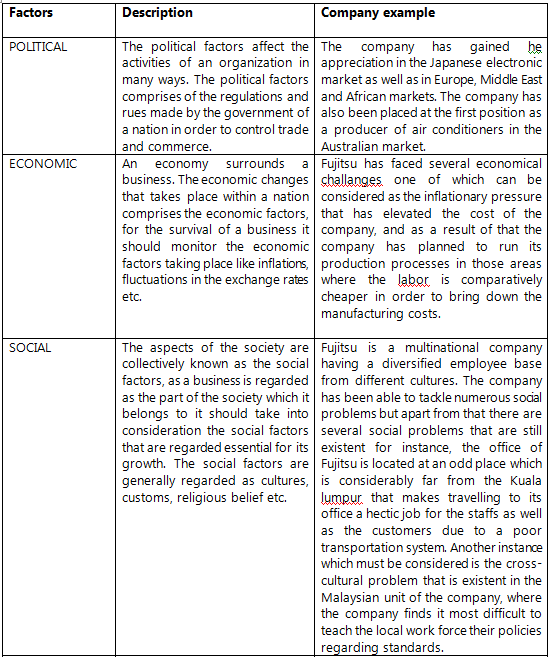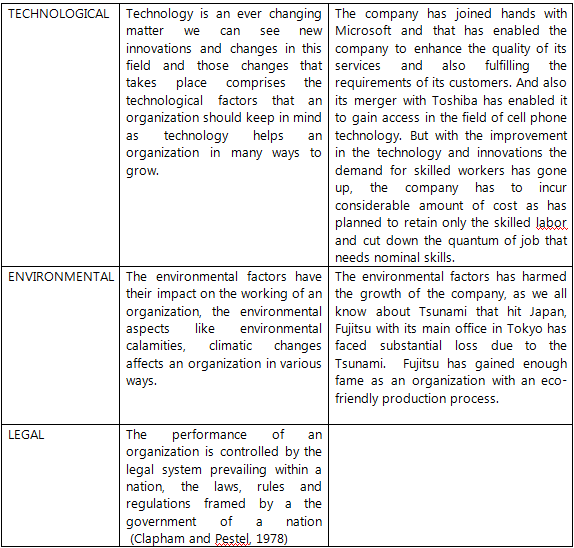- support@locusassignments.com
Unit 7 Business Strategy Sample Assignment - FUJITSU

LO 2 Be Able to Formulate a New Strategy
Q 2.1 Conduct a SWOT Analysis of the FUJITSU Corporation.
NAME OF COMPANY -
Q 2.2 Carry out a PESTEL Analysis for FUJITSU and evaluate the current challenges within the FUJITSU business environment.
PESTEL ANALYSIS FOR (Insert name of company)
Q 2.3 Conduct a stakeholder analysis for FUJITSU and explain how strategic positioning is used to help gain competitive advantage.
Stakeholders are those individuals who have a stake or interest in an organization. Stakeholders are generally interested in the objectives, activities and plans of an organization and the way it works. While the stakeholders can be both insiders and outsiders to an organization the main stakeholders are regarded as the creditors, unions, owners, employees etc.(Gledhill, 2010)
An organization improves its position by conducting a stakeholder analysis through which it identifies the stakeholders and detects their needs. The stake holder needs as identified by the organization are analyzed to based on which steps are taken to improve various aspects of law in the organization.
The expectations of the stake holders of Fujitsu can be regarded as:
Suppliers:
The suppliers are interested mainly in knowing about how quick the company is going to pay them back their money. In case of Fujitsu the suppliers are mainly concerned about the strategies of the organization aimed at building relationship with them.
Shareholders/owners:
The share holders of Fujitsu are concerned about the ability of the organization to gain considerable profits, the future plans for expansions of the company etc.
Customers:
Customers always look for the quality offered to them and also regarding the services provided by a company. In case of Fujitsu the customers are interested to know the technological improvements adopted by the company thereby improving the quality of the products delivered.
Creditors:
The creditors of Fujitsu are interested to get the information regarding the credit worthiness of the company, the position of liquidity of the company and also regarding the performance of the company. (Goodpaster, 1991)
Strategic positioning will help the company to take better decisions regarding the business as the marketing strategy of a business is developed by the strategic positioning. A business willing to create a stand point in the market requires strategic position to gain competitive advantage. As there are many
companies in the market who are regarded as competitors to Fujitsu such as Sony, IBM etc the organization is required to create a competitive advantage through strategic positioning. Strategic positioning helps in presenting different competitiveness models that can be followed by an organization. Those models are:
Cost leadership
As per this model an organization enjoys the competitive advantage by reducing its cost below the level of the cost of its competitors.
Differentiation
Under this competitiveness model a company can differentiate its products and services thereby gaining competitive advantage over its competitors.
Industry influence
Under this model an organization enjoys the competitive advantage over its competitors as by maintaining an exclusive client relationship. (Temporal, 1999)
LO3 UNDERSTAND APPROACHES TO STRATEGY EVALUATION & SELECTION
Q 3.1 Analyse the various strategic options available to FUJITSU which will promote organisational growth.
Fujitsu is a multinational company dealing in multimedia hardware and IT services, based in Japan and has its head quarter at Tokyo. The market entry or business strategy of Fujitsu is very strong and well planned; it targets and captures its market segment in a very conservative way by providing high class products to its consumers at a lower price compared to the price offered by other companies for the same product. It uses its price as the weapon of market penetration. Also the company has applied growth strategy to enter new markets as we have seen that the merger of Fujitsu with Toshiba that has helped the company in entering the market regarding cell phone in Japan.
Fujitsu is also renowned for its air conditioners that have led it to the top in this market and as a result of that the company has received huge appreciation in the Australian market. The organization has been able to capture new markets by providing newer technologies at a cheaper rate. (Lymbersky, 2008)
Prices of the products of various products by different companies are framed carefully so that it can attract customers and the company gains a position in the market. Different companies frame their pricing strategies in different way. In case of Fujitsu the prices of the products are lessened in order to attract more consumers and increase the volume of sale and also the image of the company as it aims to deliver quality products at a lower price so that the consumers can save some money. The company aims at satisfying its consumers by offering them less price compared to other companies. (Lymbersky, 2008)
The company has successfully acquired the markets of Europe, Africa and the Middle east and has also recognized as the number one seller of air conditioners in Australia. The main objective of the organization is to satisfy its consumers by7 providing efficient products at a lower price. The organization is continuously diversifying its product line as we have seen that it has merged with Toshiba in order to grab the cell phone market and also Fugitsu has been able to capture the market for air conditioners in Australia.
The company has taken effective steps to promote its brand and products on a worldwide basis. The company has promoted its brands by making various sponsorships, Fujitsu is the official sponsorer of the V8 Supercar series, it is a supercar racing series held in Australia. Fujitsu is considered as one of the renowned air conditioner seller in Australia it is also specialized in plasma display technology products. The company used the former cricketer of Australia Mark Taylor for promoting its products.
Being a big brand name Fujitsu should always aim at catching the opportunities that are generated in the market. In order to form a competitive edge the company is required to analyze its strength and weaknesses. It is also required to check its cost and should frame appropriate strategies to control the same. As it is seen that the company runs its production processes in those areas where the labor is very cheap thereby minimizing the cost. And the company should also check those segments which are not capable of providing a handsome return to the company and eliminate those units that would also lower the cost of the company.
The company should always go for diversification of its products, that will help it in growing as we have found that the merger of Fujitsu and Toshiba has helped the company in gaining access to the cell phone market.
Q 3.2 From your analysis in Q3.1, recommend an appropriate growth strategy for FUJITSU for the future.
Introduction
Fujitsu is a multinational company dealing in multimedia hardware and IT services, based in Japan and has its head quarter at Tokyo. The company has also excelled in the manufacturing of Air conditioning systems and plasma digital technology also. The company for improving its technology and diversifying its product base has collaborated with various other companies like Microsoft and Toshiba. By forming a merger with Toshiba the company has created the ability to capture the market relating to mobile phones.
Background:
In the recent past the company has experienced numerous challenging situations created by various external factors like the tsunami that took place in Japan has affected the company and its employees adversely also the war in the Middle- East has left an adverse impact on the activities of the company continued over there. Again in this world of changing trend technology is not an exception and accordingly it also keeps on changing resulting in obsolescenceof the older technologies and there is an increasing pressure of competition created by giants in this field like, Apple, Sony etc. So considering all these factors it can be said that the company should hold its position in the market by taking each and every step necessary and also it should implement change in order to keep pace with the growing trends.
Recommendations:
It is highly recommended for the company to frame and apply newer market penetration strategy to enter new markets as it has already done by making a merger with Toshiba, the organization is also required to strengthen its pricing policy because a lower price is not always welcomed everywhere by everyone so a balanced pricing policy should be in place. The company is also required a diversification in its products base by collaborating with other companies as with the diversification of its product base the company would be able to grab new markets and increase its market share. (Scott, 1989)
Advantages:
- An increase in market share implies a strong brand image and popularity.
- Balanced prices of the products will increase the number of consumers thereby increasing the market share.
- Diversification of the product base by collaboration with other organization will reduce competition and lead to exploring new markets.
Disadvantage:
- Grabbing new market involves cross cultural problem.
- Diversion in product base would create a freater pressure upon the management.
References
Bo¨hm, A. (2009). The SWOT Analysis. 1st ed. Mu¨nchen: GRIN Verlag.
Clapham, W. and Pestel, R. (1978). Policy, uncertainty, and analysis. 1st ed. Laxenburg, Austria: Internat. Inst. for Applied Systems Analysis.
Gledhill, M. (2010). Stakeholder marketing. 1st ed. Amsterdam: Elsevier/Butterworth-Heinemann.
Goodpaster, K. (1991). Business ethics and stakeholder analysis. Business Ethics Quarterly, pp.53--73.
Temporal, P. (1999). Strategic positioning. 1st ed. Shah Alam, Malaysia: Oxford University Press.
Livesey, F. (1976). Pricing. 1st ed. London: Macmillan.
Lymbersky, C. (2008). Market entry strategies. 1st ed. Hamburg: Management Laboratory Press.
Scott, D. (1989). Strategies. 1st ed. Kingston, Jamaica: Sandberry Press.
For complete copy of this assignment, order now from Assignment Help
Details
Other Assignments
Related Solution
Other Solution





